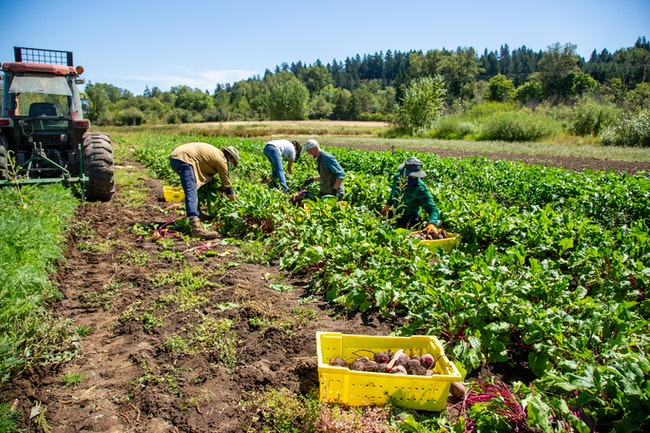
Minto Island Growers employees harvest beets on the south Salem farm (Courtesy/Marion Polk Food Share)
Oregon’s thousands of farmers and ranchers have an opportunity to garner millions of dollars in loans and free grants from the federal U.S. Department of Agriculture.
Last week the agency announced it would spend about $3 billion to transform the nation’s food system to benefit consumers, producers and rural communities by allowing midsize and small farms to expand their access to markets and give consumers a wider choice of nutritious, low-cost food.
Unlike some Midwest states focused on single crops, Oregon produces about 220 specialty crops, along with beef cattle and other livestock.
Many of Oregon’s 38,500 farms are small or midsize, making them a target for funding.
Apply for money: Oregon farmers and food manufacturers can find links to funding opportunities and application requirements here.
The new money stems from lessons learned during the pandemic and disruptions caused by Russia’s war against Ukraine, according to a USDA news release. A spokeswoman, Paige Blanchard, told the Capital Chronicle that some of the programs have allocations per state while others don’t. That means that those allocations will not be influenced by a state’s population or acreage available for farming. For farmers interested in applying, a release provides links to the various programs. The funding announcement follows the distribution of nearly $355 million to Oregon’s agricultural sector during the pandemic.
The new money intends to create more markets by funding distribution and local producers. “Having more capacity to gather, process, move and store food in different geographic areas of the country will provide more options for producers to create value-added products and sell locally, which will support new economic opportunities and job creation in rural communities,” the release said.
Supporting local producers will give people in rural areas more options and help the country move away from having the food supply reliant on large corporations, the USDA said.
“Covid has revealed the perils of a food system dominated by a few corporate players,” the statement said. “USDA’s investments will deliver a better deal for farmers, ranchers, growers and consumers.”
The funding is also designed to make nutritious food more affordable and promote equity by supporting producers in underserved and rural communities, it said: “USDA’s food system transformation investments will create more economic opportunities for these communities and allow them to retain more of the food system dollar.”
Nationally, the allocations include:
-$600 million for processing, distribution, storage and capacity needs in a variety of sectors.
-$400 million to create regional food business centers.
-$375 million for independent meat and poultry processing plants.
-$300 million to help farmers shift to organic production.
-$275 million for loans and other support for meat and poultry processing.
-$200 million for food safety certification in specialty crop programs.
-$155 million for grants and loans to entities in “food deserts” that provide affordable, healthy food.
-$100 million to train workers and develop safe workplaces in processing facilities.
-$100 million for school boards to step up efforts to improve the nutritional quality of school meals.
-$90 million to reduce food waste.
-$75 million to support urban agriculture, including community gardens.
-$60 million for commodity purchases for Farm-to-School programs.
Oregon appears to be particularly well situated to garner support to transition to organic crops. The state has 196,000 acres of organic production, the ninth highest in the country, and it’s fourth nationwide in the sale of organic food, according to the USDA. California, Washington and Pennsylvania in order rank higher.
Chris Schreiner, executive director of Oregon Tilth, which certifies organic farmers and helps with the transition, welcomed the USDA announcement.
“We were excited to hear the secretary’s announcement last week and to see that USDA understands that organic can be part of the food system’s transformation,” Schreiner said. He praised the inclusion of technical support, which he said comes up a lot when questioning farmers about the challenge to switch to organic from traditional farming.
“We hope there will be opportunities for us to partner with the USDA in outreach and technical assistance and farmer support,” Schreiner said. “We look forward to hearing more details.”
Another area likely to spark interest is the meat processing initiative. Small producers say they have trouble finding facilities to process a few animals.
Jeff Stone, executive director of the Oregon Association of Nurseries, Oregon’s biggest agricultural sector, supports grants that fund the entire production of agriculture as long as they aren’t entwined in a lot of red tape.
“The main concern I have with any effort, no matter how well intentioned it may be, is the ease of the process to get money to the producer.”
Each of the programs has different deadlines, with some within the next few months and others stretching to the end of the year.
Oregon Capital Chronicle is part of States Newsroom, a network of news bureaus supported by grants and a coalition of donors as a 501c(3) public charity. Oregon Capital Chronicle maintains editorial independence. Contact Editor Les Zaitz for questions: [email protected]. Follow Oregon Capital Chronicle on Facebook and Twitter.
STORY TIP OR IDEA? Send an email to Salem Reporter’s news team: [email protected].









